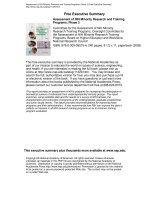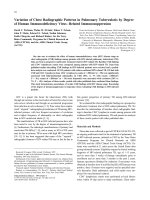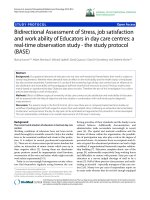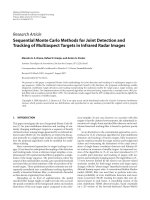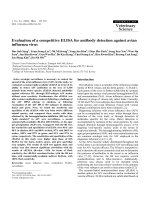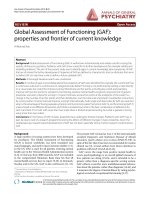Assessment of the methods for the detection of hop stunt virus and yellow speckle virus related grapevine
Bạn đang xem bản rút gọn của tài liệu. Xem và tải ngay bản đầy đủ của tài liệu tại đây (2.1 MB, 74 trang )
DAYEH UNIVERSITY
ENVIRONMENTAL ENGINEERING DEPARTMENT
COLLEGE OF ENGINEERING
Assessment of the Methods for the Detection
of Hop Stunt Virus and Yellow Speckle Virus
Related Grapevine
Student: Nguyen Phuc Thien
Advisor: Chen Yi Ching
TAIWAN 106 - 6 - 30
ABSTRACT
In this study a multiplexreverse-transcription polymerase chain reaction (mRTPCR) technique is used simultaneously to detect viroids in grapevine. Fifty grapevine
leaf samples with yellowing or mosaic symptoms were collected from difference
vineyards at Changhua County, Taiwan during May to June, 2015-2016. Specific
primer pairs for the detection of Hop stunt viroid (HSVd), Australian grapevine viroid
(AGVd), Grapevine yellow speckle viroid-1 (GYSVd-1), Grapevine yellow speckle
viroid-2 (GYSVd-2) and Citrus exocortis viroid (CEVd) were selected from previous
reports or primers were newly designed according to the sequences obtained from
NCBI Genbank. Comparison of the sequence identity of HSVd-DY with other HSVd
from GenBank ranged from 37.6% to 99.7%. While the sequence identity between
GYSVd-1-DY with others ranged from 82.9% to 99.7%. A phylogenetic tree derived
from the HSVd sequence indicated that HSVd-DY was closer to an Iran isolate
(KF916041), while GYSVd-1-DY was close related to a China isolate (JF746188).
Keywords: Multiplex RT-PCR, Grapevine viroids, phylogenetic tree, GYSVd-1,
HSVd
-iii-
中文摘要
在本研究中,多重逆轉錄聚合酶鏈反應(mRT-PCR)技術同時
被使用在檢測葡萄中的病毒。 在 2015 年及 2016 年的 5 月至 6 月期
間,從台灣彰化縣不同的葡萄園收集了五十個具有黃化或馬賽克症
狀的葡萄葉樣品。根據從 NCBI 基因庫獲得的序列,新設計的特殊
引子對被用於檢測啤酒花矮化類病毒(HSVd)、澳大利亞葡萄樹病
毒(AGVd)、葡萄黃斑類病毒-1(GYSVd-1)、葡萄黃斑類病毒-2
(GYSVd-2)及柑橘裂皮病類病毒。在比較了序列識別方面,樣品
啤酒花矮化類病毒(HSVd-DY)與基因庫的啤酒花矮化類病毒
(HSVd)之類同的範圍為 37.6%〜99.7%。而樣品葡萄黃斑類病毒1(GYSVd-1-DY)則類同範圍可達 82.9%〜99.7%。從啤酒花矮化
類病毒(HSVd)序列之演化樹推衍出樣品葡萄黃斑類病毒-1
(GYSVd-1-DY)更接近伊朗分離物(KF916041),樣品葡萄黃斑
類病毒-1(GYSVd-1-DY)則與中國分離物(JF746188)更密切相
關。
關鍵詞:多重逆轉錄聚合酶鏈式反應 、葡萄類病毒、演化樹、葡萄
黃斑類病毒-1、啤酒花矮化類病毒
-iv-
ACKNOWLEDGEMENTS
I would like gratefully acknowledge to Prof. Chen Yi-Ching (陳宜清) in the
Department of Environmental Engineering, Da-Yeh University, for his unlimited
support, instruction, and encouragement. Prof. Chen had directed me to be thorough
and offering his knowledge and experience during my research. This thesis can not be
completed without a great deal of help and encouragement from Prof. Chen.
Several professors have contributed their time graciously on my behalf, and I
would like to express my gratitude. It is a pleasure to thank the oral defense
committee, Prof. Shih Ing-Lung , Prof. Yu Shih-Chung , Prof. Yeh Philip, Prof. Lee
B. S., and Prof. Lai Chi-Yung for their time and recommendations.
I would like to thank the staffs of the Department of Environmental Engineering,
Da-Yeh University especially Ms Huang (馨嬅) for their help and support. I also
would like to thank the Dr. Doan Quang Tri (段光智) in National Center for HydroMeteorological Forecasting (NCHMF). I would like to express my gratitude towards
them.
Their advice and suggestions with insight throughout my work have evidently
supported the consistency of my dissertation.
And special thanks to all my Vietnamese and Taiwanese friends in Da-yeh for
me to live a happy life during the study. Finally, I would like to desire great thanks to
my family. Especially, I am indebted to my parents and my wife, who have been an
inspiration throughout my entire life. Without their constant support and
understanding, I would not have had the persistence to finish this work.
Nguyen Phuc Thien
June 2017, Da-Yeh University
-v-
CONTENTS
ABSTRACT .................................................................................................................. iii
中文摘要....................................................................................................................... iv
ACKNOWLEDGEMENTS ........................................................................................... v
CONTENTS .................................................................................................................. vi
LIST OF FIGURES ...................................................................................................... iv
LIST OF TABLES ......................................................................................................... x
LIST OF ABBREVIATION ........................................................................................ xii
Chapter 1.
INTRODUCTION ................................................................................... 1
1.1.
Background of Research ................................................................................. 1
1.2.
Purposes of Research ...................................................................................... 2
1.3.
Goals to Reach ................................................................................................ 3
1.4
Framework of Research ................................................................................. 3
Chapter 2.
2.1
LITERATURE REVIEWS ...................................................................... 5
Structure and Classification of Viroid ............................................................. 5
2.1.1
Structure ................................................................................................... 5
2.1.2
Classification............................................................................................ 7
2.2
Generation of Populations from Individual Viroid Variants ........................... 7
2.3
Origin and Evolution of Viroids...................................................................... 8
2.4
The Viroid Species Infect Grapevine ............................................................ 10
2.4.1
Hop Stunt Viroid .................................................................................... 11
2.4.2
Grapevine Yellow Speckle 1, 2.............................................................. 13
2.4.3
Australian Grapevine Viroid .................................................................. 13
2.4.4
Citrus Excortis Viroid ............................................................................ 13
2.5
The Detection Techniques in Viroid Disease ................................................ 13
2.6
Elimination of Viroids from Plants ............................................................... 20
Chapter 3.
STUDY METHODS .............................................................................. 21
3.1
Source of Plant Materials .............................................................................. 21
3.2
Extraction of RNA ........................................................................................ 22
3.3
Designation of Viroid-Specific Primer ......................................................... 23
3.4
The Single RT-PCR Reaction ....................................................................... 28
3.5
Multiplex RT-PCR (mRT-PCR) ................................................................... 29
3.6
DNA Elution and Cloning ............................................................................ 30
-vi-
3.7
Phylogenetic Tree Construction .................................................................... 31
Chapter 4.
4.1
RESULTS AND DISCUSSION ............................................................ 33
Results ........................................................................................................... 33
4.1.1.
Yield and quality of RNA extract .......................................................... 33
4.1.2.
Primers Design for Detection Viroids...................................... .............. 33
4.1.3. Detection of Grapevine viroids by single RT-PCR reaction……..………33
4.1.4 Development of multiplex RT-PCR reaction………………………..……34
4.1.5 T&A cloning and HindIII enzyme……………………………………..…35
4.1.6 Phylogenetic tree analysis………………………………………………...39
4.1.7 Nucleotide sequence identity..……………………………………………42
4.2
Brief Discussion of Results ........................................................................... 46
Chapter 5.
CONCLUSIONS AND SUGGESTIONS .............................................. 49
5. 1.
Conclusions ............................................................................................... 49
5. 2.
Suggestions ................................................................................................ 51
REFERENCES ............................................................................................................ 52
APPENDIX A: The rod like secondary structure of Potato Spindle tuber viroid
showing the five domains chacrateristic of members of the family Pospiviroidae: the
terminal left (TL), pathogenicity (P), central (C), variable (V), and terminal right .... 60
APPENDIX B: Map and Sequence reference points of T&A Cloning Vector
...................................................................................................................................... 61
-vii-
LIST OF FIGURES
Figure 1: Research framework ..................................................................................... 4
Figure 2: Possible evolutionary relationships between viroids and ribozymes ......... 10
Figure 3-1: Grapevine leaves collected from Changhua County, Taiwan in June 2015.
(A) Hop stunt viroid (HSVd) and Grapevine yellow speckle 1 (GYSVd-1) were
detected in the leaf samples; (B) Only GYSVd ................................................. 21
Figure 3-1 (cont): Grapevine leaves collected from Changhua County, Taiwan in June
2015. (A) Hop stunt viroid (HSVd) and Grapevine yellow speckle 1 (GYSVd-1)
were detected in the leaf samples; (B) Only GYSVd ........................................ 22
Figure 3-2: UV Spectrophotometer............................................................................ 23
Figure 3-3: Multiple sequence alignment of HSVd by CLUSTAL-W program for
primer designing. Complete sequence Hop stunt viroid was obtained from
GenBank. The asterisk indicated conserved nucleotide. Highline showed the
position of the primers ....................................................................................... 25
Figure 3-4: Multiple sequence alignment of GYSVd-1 by CLUSTAL-W program for
primer designing. Complete sequence GYSVd-1 were obtained from GenBank.
The asterisk indicated conserved nucleotide. Highline shown the position of the
primers ............................................................................................................... 27
Figure 3-5: RT-PCR Machine .................................................................................... 29
Figure 3-6: Cloning Plants ......................................................................................... 31
Figure 4-1: Agarose gel electrophoresis analyse of single and multiplex RT-PCR
reaction. Lane 1, with specific primers for GYSVd-1; Lane 2, with specific
primers for HSVd; Lane 3, with mixed primers for the detection of both GYSVd1 and HSVd. Lane M, molecular weight markers (GENMARK, GM100) ....... 35
-viii-
Figure 4-2: Agarose gel electrophoresis analyze T&A cloning vector kit insert DNA,
Lane 1,2,4,5 with specific primers for GYSVd-1, Lane 3,6 with specific primers
for HSVd. Lane M, molecular weight markers (GENMARK, GM100). .......... 36
Figure 4-3: Restriction enzyme sites of yT&A® cloning vector…………………….38
Figure 4-4: Agarose gel electrophoresis analyzes T&A cloning vector kit insert DNA
and HindIII enzyme. Lane 1,2,4,5 with specific primers for GYSVd-1, Lane 3,6
with specific primers for HSVd. Lane M, molecular weight markers
(GENMARK, GM100). ..................................................................................... 39
Figure 4-5: Phylogenetic analysis of the complete sequence of HSVd-DY with other
17 HSVd retrieved from GenBank. In the phylogenetic tree constructed using the
PHYLIP software package (Felsenstein, 2005), the values adjacent to the nodes
indicate the bootstrap confidence values for 1000 replicates using neighborjoining (NJ) analyses. Values below 75% are not given. The units of the scale bar
represent the nucleotide substitutions per site.................................................... 40
Figure 4-6: Phylogenetic analysis of the complete sequence of GYSVd-1-DY with
other 17 HSVd retrieved from GenBank. In the phylogenetic tree constructed
using the PHYLIP software package (Felsenstein, 2005), the values adjacent to
the nodes indicate the bootstrap confidence values for 1000 replicates using
neighbor-joining (NJ) analyses. Values below 75% are not given. The units of the
scale bar represent the nucleotide substitutions per site. ................................... 41
-ix-
LIST OF TABLES
Table 3-1: Primers in this work ................................................................................. 25
Table 4-1: Results of HSVd & GYSVd-1 analysis from Changhua County, Taiwan by
mRT-PCR (MP) and single RT-PCR (SP) from 2015-2016 ............................. 34
Table 4-2: The comparison of sequence identity between HSVd-DY and other HSVd
from GenBank. The accession number, infected host and isolated country are
indicated ............................................................................................................. 43
Table 4-3: The comparison of sequence identity between GYSVd-1-DY and other
GYSVd-1 from GenBank. The accession number, infected host and isolated
country are indicated .......................................................................................... 44
-x-
LIST OF ABBREVIATION
ACRONYMS
AGVd
Australian grapevine viroid
BMYV
Beet mild yellowing virus
CCR
Central conserved region
CEVd
Citrus exocortis viroid
CTV
Citrus trizteza virus
CPsV
Citrus psorosis virus
CVV
Citrus infectious variegation virus
CYCVD
Corky vein disease of citrus
PAGE
Poly-acrylamide gel electrophoresis
PLMVd
Peach latent mosaic viroid
PSTVd
Potato spindle tuber viroid
GYSVd-1
Grapevine yellow speckle viroid-1
GYSVd-2
Grapevine yellow speckle viroid-2
RT-PCR
Reverse transcription polymerase chain reaction
HSVd
Hop stunt viroid
MAbs
Monoclonal antibodies
RYMV
Rice yellow mottle virus
-xi-
SCIENTIFIC TERMS
m3/s
Cubic meters per second
l/s
Liters per second
mg/l
Milligrams per liter
kg/d
Kilograms per day
m
Meters
mm
Millimeters
-xii-
Chapter 1. INTRODUCTION
1.1 Background of Research
Viroids are the smallest known agents of infectious disease – small, highly
structured, single-stranded, circular RNA molecules that lack detectable messenger
RNA activity. Whereas viruses supply some or most of the genetic information
required for their replication, viroids are regarded as “obligate parasites of the cell‟s
transcriptional machinery” and infect only plants. Four of the nearly 30 species of
viroids described to date contain hammerhead ribozymes, and phylogenetic analysis
suggests that viroids may share a common origin with hepatitis delta virus and several
other viroid-like satellite RNAs. Replication proceeds via a rolling-circle mechanism,
and strand exchange can result in a variety of insertion/deletion events. The terminal
domains of potato spindle tuber and related viroids, in particular, appear to have
undergone repeated sequence exchange and/or rearrangement. Viroid populations
often contain a complex mixture of sequence variants, and environmental stress
(including transfer to different hosts) has been shown to result in a significant increase
in sequence heterogeneity. The new field of synthetic biology offers exciting
opportunities to determine the minimal size of a fully functional viroid genome. Much
of the preliminary structural and functional information necessary is already available,
but formidable obstacles still remain.
Sequences of viroids and viroid-like satellite RNAs were aligned separately using
CLUSTAL-X and then manually edited to preserve local similarities; these partial
alignments were then manually aligned before CLUSTAL-X was used to realign
dissimilar regions and maximize overall similarity.
-1-
Virus and viroid diseases have become increasingly important constrain to
sustainable crop production in the tropical countries. The climatic changes that are
occurring throughout the world have an impact on plants, vectors, and viruses causing
increasing instability within virus-host ecosystems.
Viroid diseases are inconspicuous compared with disease caused by fungi, bacteria
and nematodes, and loss identified in comparative trials on their effects do not
necessarily translate to global estimates of loss. Their effects also extend beyond
direct and indirect damage associated with plant virus infection largely also applies to
viroids.
Some of the threatening and economically important virus diseases in tropical
zone which affect the food production are tungro, yellow mottle, and hoja blanca in
rice; mosaic in sugarcane, mosaic in cassava; tristeza in citrus; swollen shoot in cacao;
sterility mosaic in pigeonpea; rosette, clump, and bud necrosis in peanut; necrosis in
sunflower and legumes, vegetables, and ornamental crops; yellow mosaic in legumes;
leaf curl in cotton and tomato; and ring spot in papaya.
Key factors for emergence of new plant virus and virus-like disease include the
intensification of agricultural trade (globalization), changes in cropping systems (crop
diversification), and climate change.
1.2 Purposes of Research
In Taiwan, grape cultivation is a remunerative agri-business for the highly
popular grape berries among local consumers in addition to the added values with the
processed products. The annual production of grapes was 102831 metric tons in 2010,
and 99.5% was produced in Taichung City, Miaoli, Changhua and Nantou Counties in
central Taiwan(Chiou-Chu 2013). RT-PCR has become crucial tools for detecting
viroids. Simultaneous detection and identification of viruses and viroids using
-2-
conserved primers are possible through RT-PCR, which has a higher sensitivity than
that of molecular hybridization.
Our aim of this research is to isolate and identify the causal agents of the
suspected disease in grapevines in Taiwan and to determine their phylogenetic
relatedness to the other HSVd and GYSVd-1 strains from different geographical
regions
1.3 Goals to Reach
The objectives of this study were as follows:
RT-PCR technique detect hop stunt viroid in grapevine (HSVd)
RT-PCR technique detect grapevine yellow speckle viroid 1 in grapevine
(GYSVd-1)
Multiplex RT-PCR technique simultaneously detect viroids in grapevine
1.4 Framework of Research
The framework of this research is shown as Figure 1-1. HSVd and GYSVd-1
viroid are analyzed by Clustal-W solfware. Also a conserved region is found to design
primers, then transferring to tube by using RT-PCR machine. Finally gel
electrophoresis will be run.
-3-
Figure 1.1 Framework of research
-4-
Chapter 2. LITERATURE REVIEWS
2.1 Structure and Classification of Viroid
2.1.1 Structure
Like many RNA viruses that infect plants or animals, individual viroids exist as
complex populations of often closely related sequence variants in vivo. A number of
studies have examined natural variability within viroid populations, and the Subviral
RNA Database now contains the complete sequences of more than 1,100 viroid
variants. In many cases, multiple sequence variants have been isolated from a single
infected plant.
Viroids are circular RNAs, infectious agents with a small, single-strand RNA
molecules, viroids do not code for proteins, the length of viroids is about 250 to 400
nucleotides. Viroids are able to replicate and move through infected plants, which
cause frequently severe diseases in plants to severe stunting, leaf necrosis, corky-bark,
leaf-roll and fruit deformation depending on host plant and viroid species.
They contain five structural regions: left terminal region (T1), pathogenic region
(P), central conserved region (C), variable region (V) and right terminal region (T2).
All species in the family Pospiviroidae have a rod-like secondary structure that
contains five structural/functional domains (Keese 1985) and replicates in the nucleus.
Three of the four members of the Avsunviroidae have a branched secondary structure,
and all replicate/accumulate in the chloroplast. All members of the Avsunviroidae
contain hammerhead ribozymes in both the infectious (+) strand and complementary
(−) strand RNAs. Figure 2-1 compares the secondary structures of PSTVd (rod-like,
Pospiviroidae) and Peach latent mosaic viroid (PLMVd; branched, Avsunviroidae).
With the possible exception of PLMVd, viroids do not appear to contain any modified
-5-
nucleotides or unusual phosphodiester bonds. Nucleic acid extracts from infected leaf
tissue contain a variety of viroid-related RNAs of both polarities. Some of these
molecules – especially those having a complementary or (−) strand polarity – are
considerably longer than the infectious circular viroid (+) strand. Northern analysis
using strand-specific probes and/or primer extension has shown that these molecules
represent the intermediates expected for a “rolling-circle” mechanism of replication
2.1.2 Classification
Up to now, viroid species are classified into two families Pospiviroidae and
Avsunviroidae, which are composed of five and two genera, respectively.
Pospiviroidae possess a thermodynamically stable rod-like secondary structure with a
CCR (central conserved region) and do not self-cleave, including the genera
Pospiviroid, Coleviroid, Hostuviroid, Cocadviroid and Apscaviroid. Avsunviroidae do
not possess a CCR and self-cleave via hammerhead ribozyme, with the genera
Avsunviroid and Pelamoviroid.
Nucleic acid extracts from infected leaf tissue contain a variety of viroid-related
RNAs of both polarities. Some of these molecules – especially those having a
complementary or (−) strand polarity – are considerably longer than the infectious
circular viroid (+) strand. Northern analysis using strand-specific probes and/or primer
extension has shown that these molecules represent the intermediates expected for a
“rolling-circle” mechanism of replication.
2.2 Generation of Populations from Individual Viroid Variants
Several different approaches have been used to monitor the genetic stability of
individual viroid sequence variants in vivo. These include inoculation with
-6-
recombinant plasmid DNAs (Góra-Sochacka 1997), Agrobacterium-mediated
introduction of nondisarmed recombinant Ti plasmids (Hammond 1994), and
Agrobacterium-mediated plant transformation (Wassenegger M 1994). When working
with highly debilitated variants that are only weakly infectious, constitutive
expression from an integrated transgene provides an effective means to detect the rare
events that can restore viroid infectivity. (Góra 1994) used a reverse-transcription
PCR strategy to generate, in a single step, infectious full-length cDNAs from three
phenotypically dissimilar isolates of PSTVd. When this method was applied to a
“mild” isolate, only a single sequence variant was recovered. “Intermediate” and
“severe” isolates yielded three and four variants, respectively. Not all of the variants
recovered from the severe isolate produced severe symptoms when inoculated onto
Rutgers tomato; thus, the presence of milder variants in a mixed inoculum may be
masked by variants that are more severe. Follow-up studies of (Góra-Sochacka 1997)
revealed that many of these naturally occurring PSTVd sequence variants were
unstable when inoculated alone – sometimes disappearing within a single 5~6 week
passage in tomato. This finding supports one of the basic tenets of the quasis-pecies
theory, that mixtures of variants can complement each other, and hence the whole
population is in essence a single entity analogous to an individual with thousands of
alleles rather than just two. In most cases, the new variants detected induced
symptoms that were less severe than those of the parent. The number of sequence
changes detected in both studies was relatively limited, confined almost exclusively to
the pathogenicity and variable domains with only a few changes located in the
terminal right domain.
One important advantage of screening assays that involve mechanical
inoculation of full-length viroid cDNAs or RNA transcripts is that the results are
usually available within a few weeks. Many point mutations in PSTVd and other
viroids, however, appear to abolish infectivity via mechanical inoculation. In some
-7-
cases, these mutations have been shown to inhibit replication; in other cases, cell-tocell or long-distance transport is disrupted(Qi Y 2004).
2.3 Origin and Evolution of Viroids
Several possible origins for viroids have been proposed. Viroids could be
primitive ancestors or highly degenerate derivatives of conventional viruses, but as
discussed by (Diener 1989), their unusual molecular structure and biological
properties together with a lack of sequence similarity. Evolution argues against this
possibility, of viroids from transposable elements, plasmids, or in-trons has also been
proposed. At present, the balance of evidence suggests that viroids could represent
“relics of precellular RNA evolution,” and several reviews exploring this area have
been published (Diener 2003). In essence, the argument for viroid origin in the RNA
world is straightforward: RNA is the only known biological macromolecule that can
function as both genotype and phenotype, allowing evolution to occur in the absence
of DNA or protein. As described by (Diener 1989), a simple hammerhead ribozyme
similar to those found in ASBVd and other members of the Avsunviroidae is
theoretically capable of performing all the polymerization, cleavage, and ligation steps
required for viroid replication. The circular structure of the viroid genome and the
rolling-circle mechanism of replication eliminate the need for replication to initiate at
a specific site; likewise, the apparently polyploid nature of viroid genomes (Juhasz
1988) would have favored their survival under the error-prone conditions of the
prebiotic world.
It can be compared (shown as Figure 2-1) that the structure of the first
intermediate in the PSTVd cleavage-ligation pathway (Baumstark 1997) with those of
the hammerhead and hairpin ribozymes. The upper portion of the pospiviroid central
conserved region contains a short sequence motif (GAAA) that is also present in
-8-
hammerhead ribozymes (Diener 1989). Moving from the level of RNA
primary/secondary structure to tertiary structure. However, one can see that
pospiviroid share an even greater degree of similarity with ribozymes. The hairpin
ribozyme found in (-) strand satellite RNA of Tobacco ringspot virus contains two
domains that interact in the transition state. Like the central conserved region of
pospiviroids, the loop B domain of the hairpin ribozyme also contains a loop E motif.
Loop E motifs are found in many different contexts, often acting as “organizers” for
multi helix loops in ribosomal RNAs; in the case of the hairpin ribozyme, a
conformational change in the loop E motif accompanies domain docking and is
essential for catalysis(Hampell 2001). In addition to sequence-specific cleavage, the
hairpin ribozyme also catalyzes RNA ligation. Recent experimental work with the
hammerhead and hairpin ribozymes suggests that they have more similar than
previously thought(Burke 2002), and the possibility that viroids are “relics of
precellular evolution” continues to be very much alive.
Pospiviroids and hammerhead ribozymes (lower left) both contain a short
conserved GAAA (shaded) sequence, suggesting to (Diener 1989) the possible
existence of a common ancestor in the prebiotic RNA world. The presence of a loop E
motif in the hairpin ribozyme (lower right) provides additional support for such a
relationship. The processing structure involved in the initial PSTVd cleavage (above)
does not contain a loop E motif, however. Cleavage sites in the respective RNAs are
denoted by arrows.
-9-
Figure 2-1-Possible evolutionary relationships between viroids and ribozymes.
2.4 The Viroid Species Infect Grapevine
Five viroids, Hop stunt viroid (HSVd), Australian grapevine viroid (AGVd),
Grapevine yellow speckle viroid-1 (GYSVd-1), Grapevine yellow speckle viroid-2
(GYSVd-2) and Citrus exports viroid (CEVd) have been reported to infect grapevines
(Sano 1988) although only GYSVd-1 and 2 have been shown to induce yellow
speckled symptom expression (Kolunow 1988). HSVd, AGVd, and CEVd produce no
-10-
obvious disease symptoms and infect in the grapevine unnoticed, acting as a
symptomless reservoir, which represents a potential threat to other crops.
2.4.1 Hop Stunt Viroid
The first viroid reported in grapevines was an isolate of Hop stunt viroid (HSVd)
from Japan. HSVd is a member of the Potato spindle tuber viroid group, belonging to
the family Pospiviroid. HSVd apparently has a wide host range and besides hopping
it can propagate in cucumber, grapevine, citrus, plum, peach, pear (Teruo 1989),
apricot and almond plants (Polivka 1996). Eighty-four HSVd sequences are present in
the subviral RNA database (Pelchat 2003). Hop stunt viroid (HSVd) infects a large
number of woody plant hosts such as Prunus spp., Citrus spp., and Vitis spp. HSVd
along with Citrus exocortis viroid (CEVd) has been detected in both citrus and
grapevines. Hence, to differentiate these two viroids, total RNA from leaves of
grapevine Vitis vinifera „Cabernet Sauvignon‟ and V. labrusca „Niagara Rosada‟ was
used as a template for RT-PCR assay. Primers specific for HSVd, CEVd, Grapevine
speckle viroid 1 (GYSVd-1), Grapevine speckle viroid 2 (GYSVd-2) and Australian
grapevine viroid (AGVd) were employed. The PCR amplicons were cloned and
sequenced. The grapevine samples analyzed showed the presence of both HSVd and
CEVd. Phylogenetic analysis showed that Brazilian grapevine HSVd variants
clustered with other grapevine HSVd variants, forming a specific group separated
from citrus variants. On the other hand, the Brazilian CEVd variants clustered with
other citrus and grapevine variants (Eiras 2000). Molecular characterization of Hop
stunt viroid (HSVd) isolates from different naturally infected Prunus sources including
apricot, plum and peach were performed by determining the nucleotide sequences of
eleven isolates. Five new sequence variants of 296-nt (3 variants) or 297-nt (2
variants) comparable to the known HSVd isolates were identified.
-11-
Association of Hop stunt viroid (HSVd) with yellow corky vein disease of citrus
(CYCVD) occurring in India was investigated to establish its causal relationship with
the disease. In silico analysis showed that HSVd has 295 nucleotides and that the
isolates exhibited nearly 100% nucleotide identity with six citrus cachexia isolates of
HSVd. This variant was tentatively designated Hop stunt viroid-ycv (Roy 2003). Later
Citrus exocortis viroid (CEVd) was also found to be associated with CYCVD.
BLAST analysis revealed the alignment of the sequences with a different CEVd. The
isolates from CYCVD-infected plants was tentatively named as a variant of CEVdycv. This variant showed close relationship with CEVd Gynura variants reported from
Australia (Roy 2006).
Phylogenetic analyses indicated that one apricot isolate clustered with a
recombinant group, whereas all others (one apricot, two plum and one peach isolate)
clustered with the hop-group, confirming the genetic diversity of HSVd isolates. The
sequence variability appeared to be more related to the geographical origin of the
isolates than to their hosts (Gazel 2008).
2.4.2 Grapevine Yellow Speckle 1, 2
The first described Grapevine yellow speckle disease to be caused by viroids in
grapevine to date(Kolunow 1988). Some of the infected plants developed yellow
speckle symptoms indicating that both viroids can cause Grapevine yellow speckle
disease. GYSVd-1 is the causal agent of yellow speckle disease. They are direct or
indirect associated with plant virus infection in the field (Woodham.R.C 1972).
The foliar symptoms of yellow speckle are often absent in confined to a few
yellowish spots or flecks scattered in tissue along major or minor veins of leaves
(Szychowski 1998). GYSVd-1 is the most closely related viroid to GYSVd-2 with an
overall sequence. Similarly, that occurs between the two species.
-12-
2.4.3 Australian Grapevine Viroid
Australian grapevine viroid (AGVd) is a novel viroid with less than 50%
sequence similarity with any known viroid. Nevertheless, its entire sequence can be
divided into regions, each with a high sequence similarity with segments from one of
citrus exocortis, potato spindle tuber, apple scar skin, and Grapevine yellow speckle
viroids. AGVd contains the entire central conserved region of the apple scar skin
viroid group and is proposed as a member of this group(Kolunow 1988).
2.4.4 Citrus Excortis Viroid
CEVd has a wide host-range, that is, in addition to citrus (Fawcett 1948) and
grapevine (García-Arenal 1987), it infects some species in the family Compositae
(Niblett 1980), Solanaceae (Morris 1977). Leguminosae, Brassicaceae, and
Moraceae, such as chrysanthemum (Niblett 1980), tomato (Mishra 1991), broad bean
(Fagoaga 1995), eggplant, turnip carrot (Fagoaga 1996), and fig (Yakoubi 2007),
respectively.
2.5 The Detection Techniques in Viroid Disease
Viroids are commonly detected by electron microscopy and biological
characterization, based on host range, bioassay, poly-acrylamide gel electrophoresis
(PAGE), molecular hybridization, RT-PCR-enzyme-linked immune-sorbent assay
(RT-PCR-ELISA), real-time PCR and RT-PCR.
A real-time
polymerase
chain
reaction (qPCR)
is
a laboratory
technique of molecular biology based on the polymerase chain reaction (PCR). It
monitors the amplification of a targeted DNA molecule during the PCR, i.e. in real-
-13-
